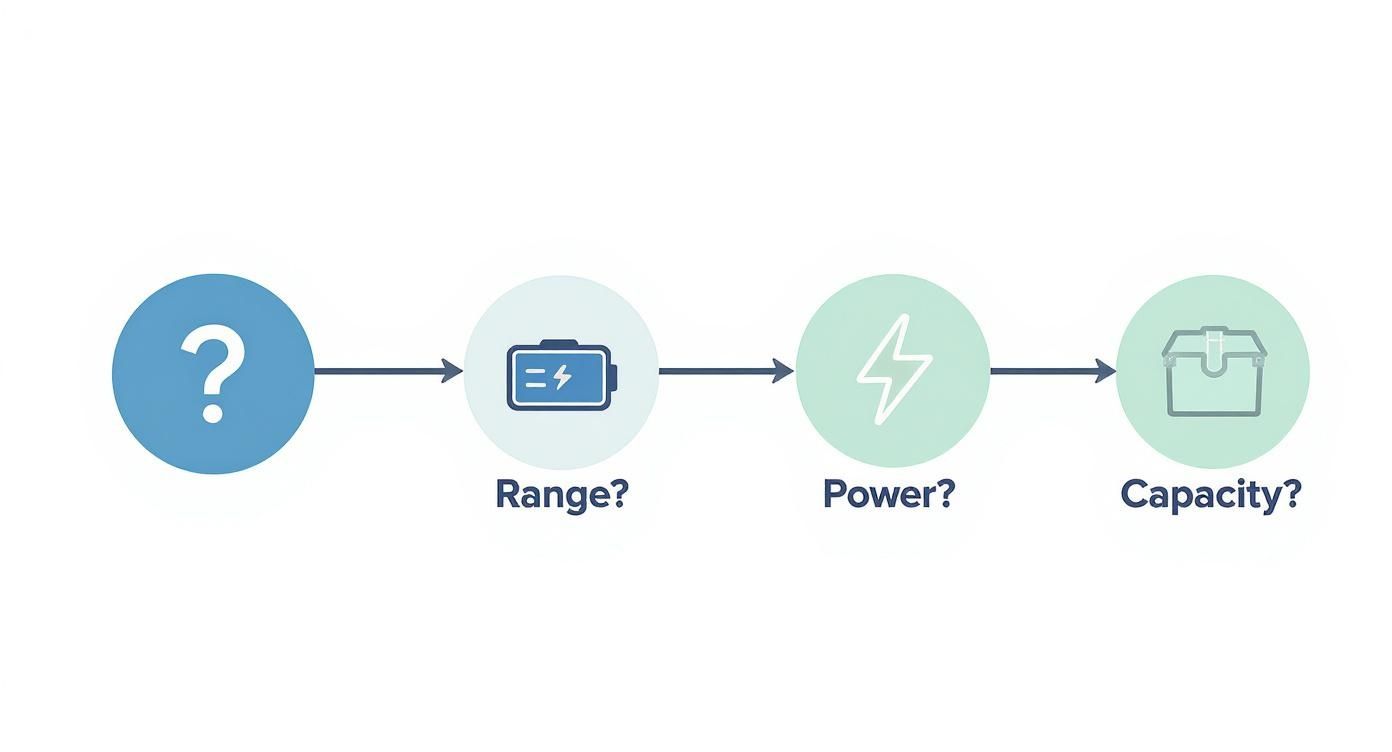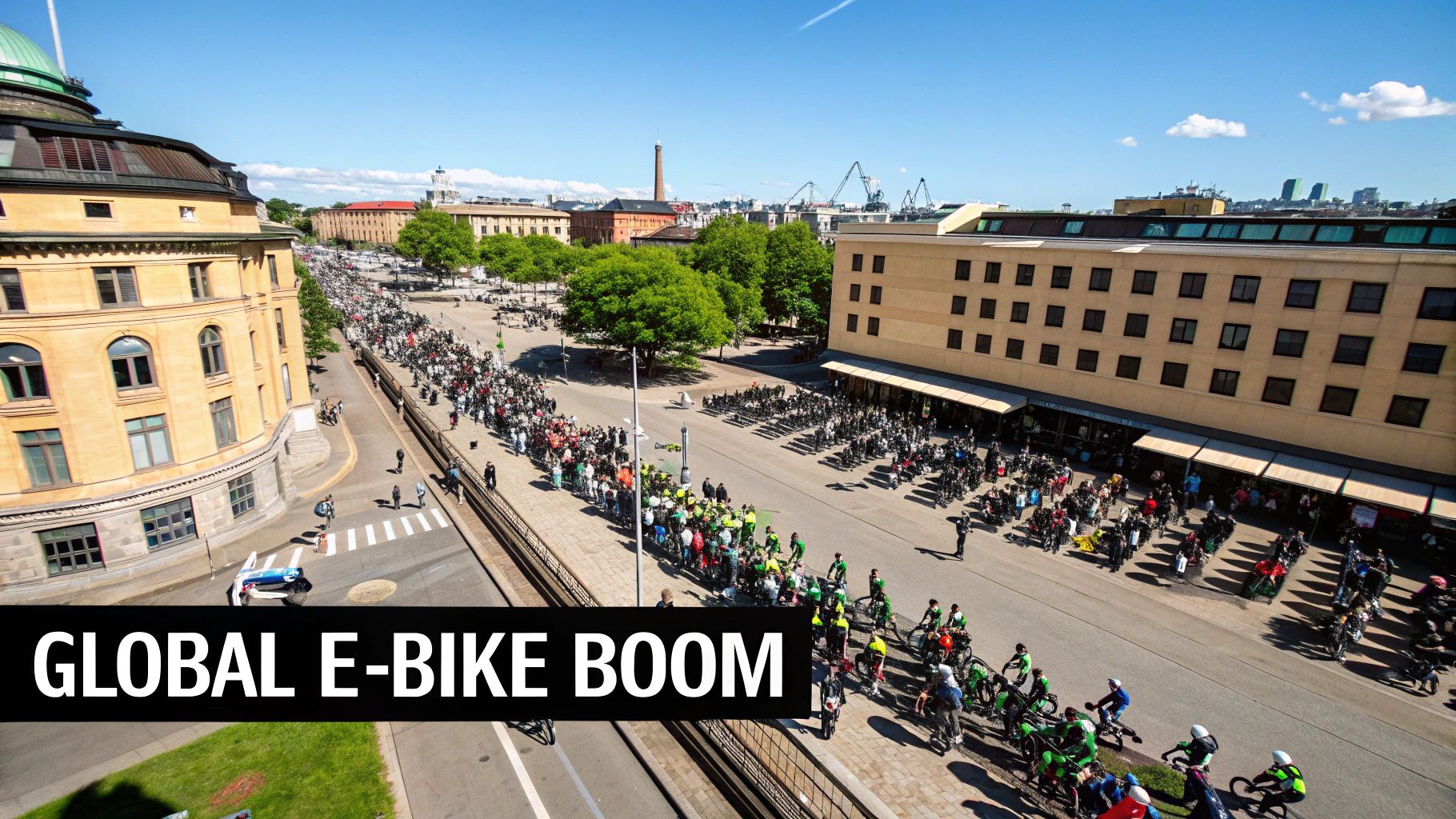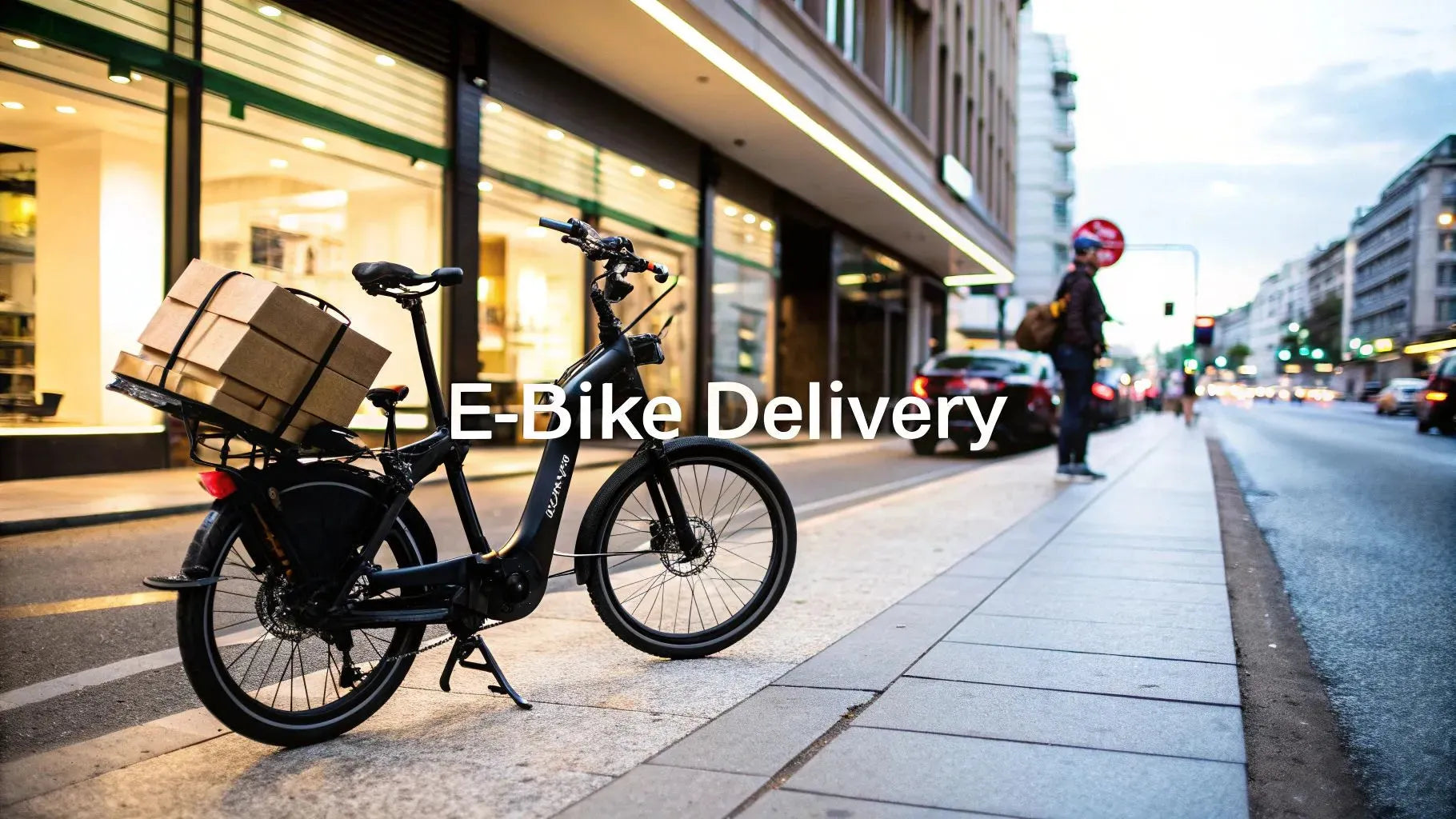Picture this: you're zipping past bumper-to-bumper city traffic, dropping off more packages per hour, and saving a small fortune on fuel and running costs. That's the new reality for businesses using an electric bicycle for delivery, a surprisingly simple switch that’s completely changing the game for urban logistics across Australia and the US. This isn't just a fleeting trend; it’s a genuinely smarter way to get things done.
Why Your Next Delivery Vehicle Should Be an E-Bike
Let's be honest, the days of delivery vans being the only real choice for city routes are coming to an end. Between choked city centers, skyrocketing fuel prices, and the push for cleaner air, businesses are being forced to find a better way. For a growing number of them, the answer is a purpose-built electric delivery bike—a machine that turns logistical nightmares into a real competitive edge.

Think about a small bakery in downtown Sydney. They used to rely on a single van for all their daily wholesale drops. The driver spent almost half their shift either stuck in traffic or circling the block looking for a parking spot. The result? Late deliveries and eye-watering fuel bills. After they switched to a couple of cargo e-bikes, everything changed.
Their riders could now dive into bike lanes to completely bypass gridlock, getting to more customers in way less time. Their running costs dropped through the floor, and their clients absolutely loved the new, eco-friendly deliveries.
Slashing Costs and Boosting Efficiency
When you dig into the numbers, the financial and green benefits are just incredible. E-bikes have totally shaken up the delivery world by slashing both operational costs and environmental impact. An average e-bike spits out just 4.9 grams of CO₂ per mile. For comparison, a typical petrol car emits around 274 grams per mile—that’s a staggering 98% reduction in emissions. You can dive deeper into these kinds of e-bike statistics over at boltbikers.com.
But this shift is about so much more than just saving a few dollars on gas. It’s about rewriting the entire delivery equation. An e-bike means more drops per hour, next to no maintenance, and zero charges for driving in low-emission zones.
Delivery E-Bike vs Van: A Head-to-Head Comparison
To really see the difference, let’s put the two options side-by-side. Here’s a quick breakdown of how an electric delivery bike stacks up against a traditional van for those typical urban routes.
| Factor | Electric Delivery Bicycle | Traditional Delivery Van |
|---|---|---|
| Upfront Cost | Low (around $2,500-$6,000) | High ($30,000+) |
| Running Costs | Extremely Low (pennies to charge) | High (fuel, registration, insurance) |
| Speed in Traffic | Very High (bypasses congestion) | Very Low (gets stuck) |
| Parking | Easy & Free (park almost anywhere) | Difficult & Expensive |
| Emissions | Near-Zero | High |
| Regulation | Minimal (no special license, no rego) | Complex (licensing, inspections) |
As you can see, for last-mile delivery in a busy city, the e-bike wins on almost every front.
The Immediate Payoff
Making the switch to an electric delivery bicycle isn't a long-term gamble; the return on investment is clear and almost immediate. Here are the biggest wins you'll see right away:
- Fly Through the City: You can weave through traffic and zip down shortcuts that are totally off-limits to vans. This alone drastically cuts down your delivery times.
- Slash Your Expenses: Kiss goodbye to fuel costs, pricey insurance premiums, and those dreaded parking tickets.
- Boost Your Brand Image: Showing you’re committed to sustainability is a huge plus for today's eco-conscious customers. It really makes your business stand out.
- Happier, Healthier Riders: Your couriers get some gentle exercise and avoid the daily stress of battling city traffic, which leads to much better job satisfaction.
So, What's Behind the E-Bike Delivery Boom?
Let's be clear: the shift to electric delivery bikes is much more than a trend. It's a fundamental change in how things get from A to B in our cities, and it’s happening fast. Think of it less like a small stream and more like a river carving a new path through the urban landscape, especially in places like Melbourne and New York.
Why the sudden surge? It’s pretty simple, really. Fuel prices are through the roof, making traditional delivery vans a serious drain on the budget. On top of that, cities are cracking down hard on congestion and pollution.
The Big Squeeze on Traditional Deliveries
Take New York City's congestion pricing plans, for instance. Driving a polluting van into Manhattan means getting hit with a hefty daily charge. For a small business with a few vans on the road, that adds up to a crippling expense. An e-bike, on the other hand? It glides right through, producing zero emissions and costing zero in charges. That’s a daily cost wiped right off the books.
At the same time, we've all gotten used to getting what we want, when we want it. Whether it's a hot pizza or a last-minute package, we expect it at our door almost instantly. This is where the nimble electric delivery bike shines, zipping past traffic jams that leave vans sitting idle for ages.
Switching to an e-bike isn't just a smart move for today. It's about future-proofing your operations for the even tougher regulations and higher running costs that are definitely coming our way.
A Market That's Exploding
This isn't just a feeling; the numbers are staggering. The global e-bike market was recently valued at around USD 61.89 billion. Projections show it rocketing past USD 113 billion by 2030. A huge slice of that growth comes from commercial use—think courier services and all those last-mile deliveries. If you're curious, you can dig into more insights about this global logistics shift.
You can see this playing out across North America and Australia. Big-name delivery giants are rolling out entire fleets of e-bikes in cities like San Francisco and Melbourne. They've figured out that for getting around a crowded city core, an e-bike isn't just a green alternative; it's often the better, faster tool for the job.
Just look at Amazon. In Manhattan, they now handle the bulk of their Whole Foods and Amazon Fresh deliveries with e-bikes. It lets them get groceries to people's doors faster while slashing their carbon footprint. By bringing an electric bicycle for delivery into your own business, you're tapping into a model that's already been proven to work, giving you a real leg up on the competition stuck in traffic.
Finding the Perfect Features for Your Delivery E-Bike
Picking the right e-bike for delivery work isn't the same as choosing a bike for a casual weekend spin. This bike is your business partner. It's your workhorse. It’s what helps you put more money in your pocket at the end of the day. So let's cut through the confusing tech specs and talk about what really matters for your daily grind.
Forget about jargon like 'watt-hours'. Let's frame battery life in a way that actually counts: how many drops can you make before you're forced to recharge? A weak battery can die on you mid-shift, sending you back to base and costing you time and money.
A solid delivery e-bike needs to give you a real-world range of at least 40-60 miles (65-95 km) on one charge, even when you're loaded up. That's the sweet spot to get you through a full shift without constantly worrying about your battery level.
Powering Through Your Toughest Routes
Alright, let's talk about the motor. Your e-bike's motor is the difference between a frustrating slog and a smooth, easy ride. It’s what separates you from conquering a steep hill with a heavy food order and having to hop off and push.
For serious delivery work, especially if your city isn't completely flat, you'll want a motor with at least 50 Newton-metres (Nm) of torque. Torque is that initial grunt that gets you going at a traffic light and pulls you up inclines without a struggle. It’s the muscle.
Think of motor power like having a strong buddy giving you a constant push. A powerful motor means you finish your shift with more energy because the bike did the heavy lifting when it mattered most.
A good motor doesn't just make the job easier; it saves your legs, keeping you fresh for those longer, more profitable shifts.
Built to Carry and Built to Last
Your delivery e-bike has to be tough. Period. It's going to be ridden hard every single day, in all kinds of weather, carrying different loads over potholed city streets. Durability isn't a nice-to-have, it's an absolute must for a bike that works as hard as you do.
Here’s a quick rundown of the essential specs that truly matter for a reliable delivery workhorse.
Must-Have Specifications for a Delivery E-Bike
| Feature | What It Means for You | Why It's Critical for Delivery |
|---|---|---|
| Sturdy Frame | A reinforced aluminum or steel frame that won’t buckle under pressure. | It needs to withstand the daily stress of heavy loads and constant stop-and-go riding without failing. |
| Puncture-Resistant Tires | Tires that can shrug off glass, thorns, and other road debris. | A flat tire mid-delivery is a massive headache that costs you time and income. This is your best defense. |
| Hydraulic Disc Brakes | Superior stopping power you can count on, rain or shine. | City traffic is unpredictable. You need to be able to stop on a dime to stay safe. |
| Integrated Cargo Racks | Strong, built-in racks on the front or rear of the bike. | You need a solid platform designed to securely carry everything from food bags to parcels without wobbling. |
These features aren't just about performance; they're about keeping you safe, efficient, and profitable on the road.
Speaking of cargo, pay close attention to the bike's payload capacity—that’s the total weight it can safely carry, including you and your packages. A proper delivery e-bike should handle at least 120-150 kg (260-330 lbs) to give you plenty of flexibility. Of course, you'll want to add things like insulated bags and panniers, and our guide on the best electric bike accessories is a great place to start looking for the perfect gear to complete your setup.
How to Choose the Right E-Bike for Your Business
Let's be honest, not all delivery e-bikes are built the same. Picking the right one is a bit like choosing a tool from a toolbox; you wouldn't grab a sledgehammer when you need a screwdriver. This is your guide to playing matchmaker, pairing your business with the perfect electric bike.
Think of it in car terms. Heavy-duty cargo e-bikes? They’re the pickup trucks of the bike world. Built with beefy frames and a massive carrying capacity, they're perfect for a grocery delivery service in central Chicago that needs to haul heavy loads all day long.
Then you have your versatile longtail models. These are more like the family SUV—still able to carry bulky or awkward items but with more agility than a full-on cargo rig. They're a fantastic choice for florists or bakeries that have to move delicate, oversized goods without a fuss.
And finally, you've got the nimble hybrid bikes. These are the speedy little hatchbacks, built for zipping through packed city streets. A document courier in Brisbane or a DoorDash rider would find this style ideal for making quick, time-sensitive drops where every second counts.
Matching the Bike to the Job
To get this right, you need a clear picture of your day-to-day. What are you actually delivering? How much does it weigh? How far do you really need to go on a single charge?
Answering these questions honestly will point you in the right direction. A bike with a massive payload capacity might look impressive, but if you're only delivering small, light parcels, you're just lugging around extra weight for no reason. That's a surefire way to drain your battery faster.
This decision tree infographic is a great starting point, breaking down the key questions to ask yourself. It helps you narrow down your options based on what truly matters: range, power, and capacity.

As you can see, it all starts with the demands of your job. Once you know that, the technical specs you need in an e-bike become much clearer.
Cargo E-Bikes: The Heavy Lifters
When it comes to carrying capacity, cargo bikes are the undisputed champs. With payload limits often pushing past 200 kg (440 lbs), they can genuinely replace a small van for many city delivery routes.
- Pros: Unmatched cargo space, incredibly stable even with heavy loads, and built like a tank for durability.
- Cons: They're heavy and less nimble in tight spots, which can be tricky in super congested city centers.
Longtail E-Bikes: The Versatile All-Rounders
Longtail bikes strike a brilliant balance. Their extended rear rack gives you tons of space for big panniers or boxes without the sheer bulk of a full-blown cargo bike.
- Pros: Great cargo capacity, but it handles more like a regular bicycle. Super versatile for mixed-use deliveries.
- Cons: Can feel a little less stable with really heavy or lopsided loads compared to a dedicated cargo model.
It's also crucial to think about the total weight, including the rider. If you need a bike that can handle a higher overall payload, our guide on the best e-bike for heavy riders is definitely worth a read.
Hybrid E-Bikes: The Urban Speedsters
For jobs where getting there fast is the name of the game, a hybrid e-bike is the only way to go. They’re lightweight, quick, and perfect for slicing through dense traffic.
Once you visualize which bike fits into your daily routine, you can pick a model that will become the most valuable—and profitable—player in your entire workflow.
Navigating US & Australian E-Bike Rules for Commercial Riders
Getting into delivery riding is a great move, but the legal stuff can seem a bit intimidating at first. The rules in the US and Australia can vary between states, but the general principles are designed to make using e-bikes safe and straightforward.
Let's cut through the jargon. Most laws are built around a "class" system (in the US) or power/speed limits (in Australia). If your e-bike fits into the standard legal categories, it's treated much like a regular bicycle.
Sticking to these rules means you generally won't need a special license, registration, or motor insurance. However, it's vital to check the specific regulations for your state or territory, as they can differ.
What Makes an E-Bike Street Legal?
The core rules are all about keeping things safe for everyone on the roads and bike paths. Here’s a general guide for a street-legal delivery e-bike in these regions:
- Motor Power: In Australia, the motor's power is generally limited to 250 watts. In the US, Class 1 and 2 e-bikes are typically capped at 750 watts (1 hp).
- Top Speed: The electric assist usually has to cut out at 25 km/h (15.5 mph) in Australia and 20 mph (32 km/h) in the US.
- Pedal-Assist vs. Throttle: In Australia, the motor should only assist while you're pedaling. The US has a class system: Class 1 is pedal-assist only, while Class 2 allows for a throttle. Class 3 bikes offer pedal-assist up to 28 mph but may have more restrictions. For most delivery work, Class 1 or 2 is ideal.
The real beauty of having a compliant e-bike is all the red tape you get to avoid. No driver's license, no vehicle registration, and no pricey motor insurance in most cases. It's that simple.
Staying Safe and Covered on the Road
Just because you don't need motor insurance doesn't mean you should ride without any cover. Getting public liability insurance is a really smart idea for any delivery rider. It's there to protect you financially if you're ever in an accident.
And of course, don’t forget the essentials. Helmet laws are strictly enforced in Australia and many US states, so a good helmet is non-negotiable. High-vis gear is also a must, especially if you're riding after dark or when the weather turns nasty.
These rules are designed to make using an electric bicycle for delivery as easy as possible. For a deeper dive, check out our guide on whether electric bikes are street legal. Follow these guidelines, and you can put your energy into what actually matters: making your deliveries and earning your money.
What We Can Learn from E-Bike Delivery Champs Around the World
To really get a handle on what delivery e-bikes can do, we need to look beyond our own backyards. The biggest success story by a mile comes from China, where e-bikes aren't just a fun gadget—they're the very lifeblood of urban logistics. The scale of it all is a masterclass in getting things done efficiently.

This wasn't just some minor tweak to their delivery system; it completely rewired how their cities operate. Think less traffic clogging up the streets, cleaner air, and a local economy that moves at lightning speed. Millions of couriers depend on these zippy bikes to earn a living, creating a massive on-demand network that just works.
The Numbers Don't Lie
The stats are pretty mind-boggling. Way back in 2013, China cranked out a staggering 37 million electric bicycles and sold 32 million of them right at home.
Just for comparison, Europe sold about 1.8 million that year, and the United States a mere 185,000. These figures, which you can dig into deeper with global e-bike data on Statista, show more than just manufacturing muscle. They reveal a country that has fully embraced e-bikes for commercial delivery on an epic scale.
This isn't just a fun fact from the past. It’s the groundwork for a system where e-bikes are the go-to tool for last-mile delivery, not just a quirky alternative.
Bringing Global Lessons Home
So, what does this mean for a small business in Australia or a startup in the US? Simple: e-bikes give you a real, tangible edge, especially when you're navigating crowded city streets.
By putting e-bikes at the core of your strategy, you can create a delivery operation that's faster, cheaper to run, and better for the planet—leaving competitors stuck in their traditional vans eating your dust.
The Chinese model shows us that an electric delivery bicycle is way more than just a way to save a bit of cash. It’s a game-changing tool that lets your business be quicker and more agile. The same logic that works for millions of deliveries in Asia—speed, low costs, and a green footprint—can give any American or Australian delivery service a clear path to working smarter.
Got Questions? We’ve Got Answers.
Thinking about making the switch to an electric delivery bike? You're not alone. Here are the most common questions we get from riders and businesses weighing their options.
How Much Upkeep Does a Delivery E-Bike Really Need?
Honestly, not that much more than a regular bike. You'll still need to keep an eye on the basics: tires, brakes, and the chain. The good news is that the electrical bits—the motor and battery—are surprisingly low-maintenance.
If you're using it daily for deliveries, getting it professionally serviced every 6-12 months is a smart move. The two biggest things you can do yourself are charging the battery properly and keeping the bike dry. Do that, and it'll serve you well for years.
Can I Actually Ride an Electric Delivery Bike in the Rain?
Yes, you absolutely can. Any decent delivery e-bike is built to be water-resistant. The important components like the motor and battery are sealed up tight to handle a downpour. Just don't go riding through deep puddles or blast it with a pressure washer.
For your own sake (and to keep your deliveries dry), a good set of waterproof panniers and proper riding gear is a must for any serious courier.
A purpose-built delivery e-bike is a reliable tool, designed to handle the demands of a four-season job. Think of it less like a fragile gadget and more like a rugged workhorse that's ready for almost any weather.
What's a Realistic Budget for a Good Delivery E-Bike in the US or Australia?
You should plan on investing between $2,000 and $5,000 for a solid, purpose-built electric delivery bike. You'll definitely see cheaper options out there, but this is one of those times where paying more upfront really pays off.
Spending a bit more gets you a tougher frame, a top-notch battery, and a powerful motor from a brand you can trust. That initial investment will save you a ton of cash (and headaches) on repairs and downtime later on.
Ready to make your deliveries faster, cheaper, and a whole lot greener? Find the perfect electric delivery bicycle for your hustle over at Punk Ride LLC. Check out the range at https://www.punkride.com.





Share:
Are Electric Bikes Waterproof? Your Guide to Safe Riding in Any Weather
Are Ebikes Waterproof? Your All-Weather Riding Guide